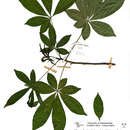Description
provided by Flora of Zimbabwe
Medium-sized to large deciduous tree. Bark smooth, greenish yellow. Leaves spirally arranged at the ends of branches, digitate with 3-7 leaflets; leaflets oblong-elliptic, largest up to 2 × 2 cm; apex attenuate; margin entire. Flowers axillary, solitary or in 2-5 flowered clusters, large and striking, up to 18 cm in diameter, pale yellow to apricot with red stamens. Fruit an ovoid woody capsule, c. 6 cm long, dehiscent, splitting into 5 valves, revealing numerous brown seeds, embedded in a wool of reddish brown silky hairs.
- license
- cc-by-nc
- copyright
- Mark Hyde, Bart Wursten and Petra Ballings
- bibliographic citation
- Hyde, M.A., Wursten, B.T. and Ballings, P. (2002-2014). Bombax rhodognaphalon K. Schum. Flora of Mozambique website. Accessed 28 August 2014 at http://www.mozambiqueflora.com/speciesdata/species.php?species_id=167500
- author
- Mark Hyde
- author
- Bart Wursten
- author
- Petra Ballings
Worldwide distribution
provided by Flora of Zimbabwe
Kenya and Tanzania southwards to Mozambique
- license
- cc-by-nc
- copyright
- Mark Hyde, Bart Wursten and Petra Ballings
- bibliographic citation
- Hyde, M.A., Wursten, B.T. and Ballings, P. (2002-2014). Bombax rhodognaphalon K. Schum. Flora of Mozambique website. Accessed 28 August 2014 at http://www.mozambiqueflora.com/speciesdata/species.php?species_id=167500
- author
- Mark Hyde
- author
- Bart Wursten
- author
- Petra Ballings
Bombax mossambicense: Brief Summary
provided by wikipedia EN
Rhodognaphalon mossambicense, the East African bombax or wild kapok tree, is a species of flowering plant in the family Malvaceae. It occurs from southeastern Kenya through the coastal and Eastern Arc forests of Tanzania to northern Mozambique and Malawi.
Its seeds are roasted and eaten, either whole or pounded into a powder which is then used in cooking.
- license
- cc-by-sa-3.0
- copyright
- Wikipedia authors and editors

